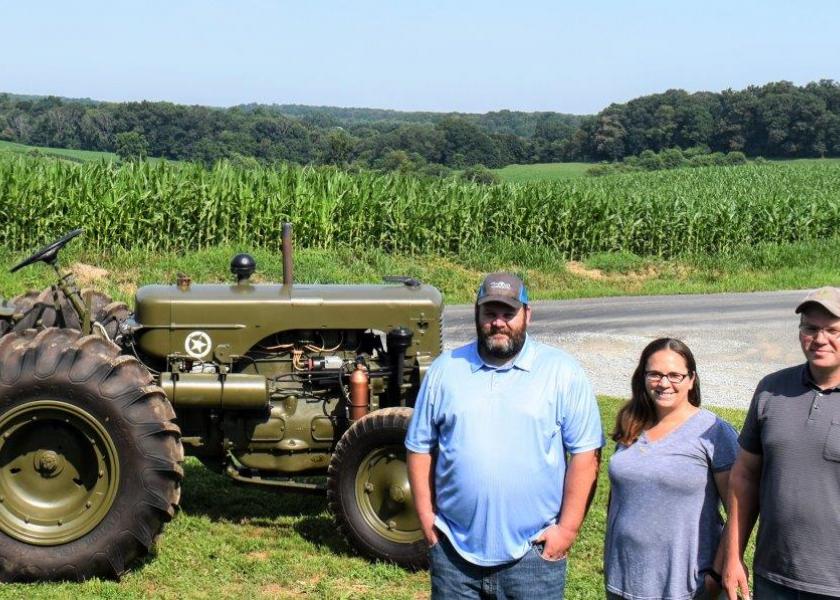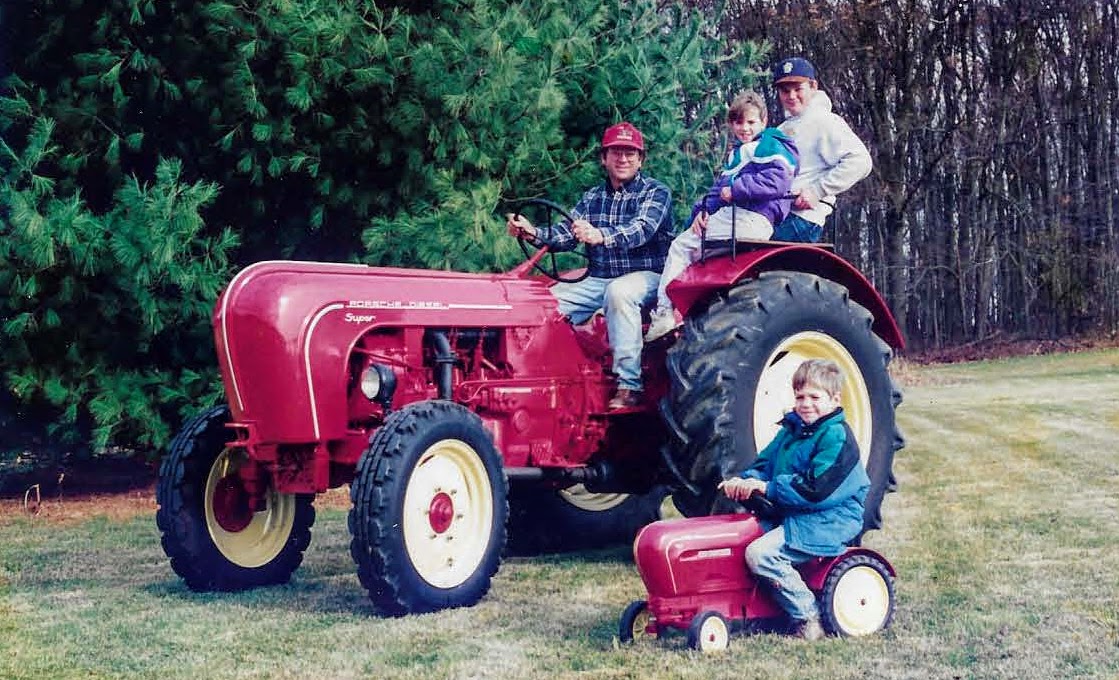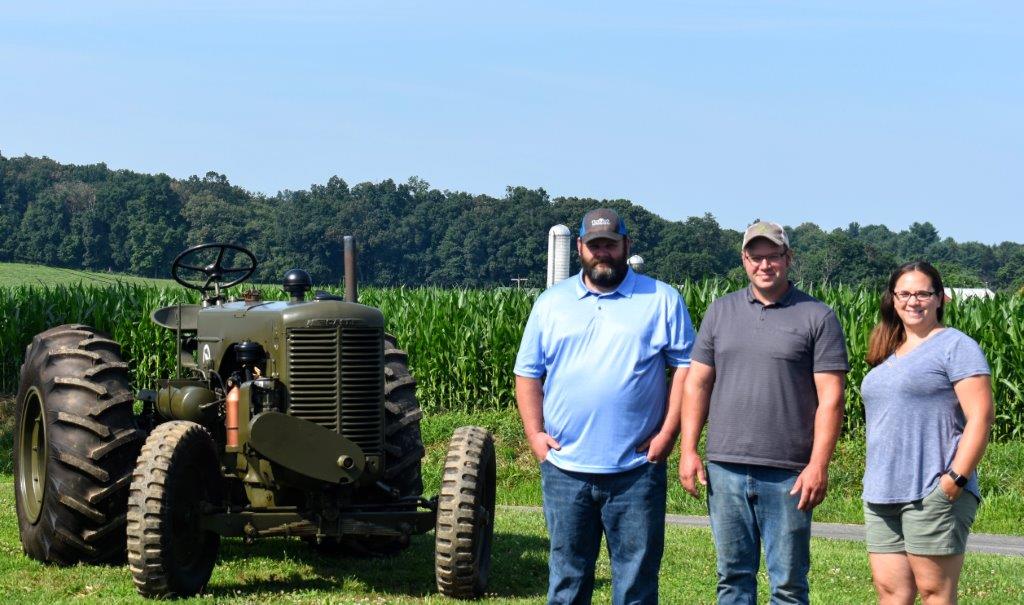Beast to Beauty: Auction Find Reveals Historical Tractor and Family Treasure

In the crisp cold of a frigid February morning, as a curious tractor hit the auction block, a crowd of farmers remained silent and still until a small hand broke the canopy of ball caps and darted into the air. A nine-year-old boy bid on a mysterious, 8,000-lb. piece of the past hidden beneath seven coats of paint—an ugly, yellow tractor sporting the unlikely hiss of air brakes. The young boy, through the wisdom of his father, saw what the throng failed to see: An absolutely beautiful treasure of American history.
In 1998, a Case LAI Military tractor, one of only 200 manufactured during World War ll for the U.S. Army Ordinance Division, emerged from yesteryear and quietly hit the floor of a Pennsylvania auction—fortuitously found by Maryland dairyman Dan Magness and his three young children. The Case LAI, subsequently hauled to the Magness family farm and painstakingly restored in pristine, olive drab detail to its 1944 origins, is an exemplar of U.S. ingenuity, as well as a tribute to the late Magness’ remarkable craftsmanship.
The Case LAI was one link in chain of phenomenal restoration projects steered by Magness, including sleek rebuilds of Porsche, Twin City, and Field Marshall tractors, but his motivation to restore forgotten machinery was not fueled by aesthetics or visuals. Gone since 2018, Magness was driven by history and a deep-seated desire to pass on indispensable skills to his sons and daughter. By way of a Case LAI and a series of other tractor tales, Magness shaped his family for life.
Porsche Red
In the hills of northeast Maryland, just outside White Hall, in Harford County, roughly 5 miles below the Mason-Dixon line, Magness ran a dairy operation and grew corn, soybeans, and wheat. With a razor-sharp intellect and an agriculture engineering degree from Penn State University, Magness was obsessed with mechanical function. He initially channeled his fascination into the production of homemade farm equipment, but with the birth and rearing of three kids—Dan Jr., Erin, and Ben—Magness was drawn to tractor restoration in the early 1990s, partially as a means to bond with his children.
“Antique tractors became a perfect fit and outlet for my dad,” says Ben, 32, who now holds the dairy and row crop reins on the Magness operation. “He started fixing all kinds of old machinery when he was a young man, but when we came along, he got into tractors to have us all involved. It was so important to him to have all of us working together on stuff with our hands. In a really great way, mechanics kept us all close.”
In 1994, Magness took a blind shot and placed a wanted ad in a local farming newspaper, seeking a 1950s-era Porsche tractor, and was met by zero takers—no response. Magness had never set eyes on a single specimen of a Porsche tractor, but overwhelmed with interest, he ran the ad again...and again. Months later, his persistence struck a bull’s-eye, and after a series of phone calls with a prospective seller, a 1957 Porsche Super Tractor arrived on the Magness farm—with many of the component parts delivered inside innumerable 5-gallon buckets.
With all three children at his side, Magness set to work on the German-manufactured skeleton, meticulously piecing together a steel puzzle. “He didn’t make us watch, but instead he let us work right with him, learning by doing,” Ben explains. “Mechanical ability on the farm was crucial to him, and it helps me to this day, and also helps my brother, who went on to become a diesel mechanic. Working as kids on an air-cooled Porsche diesel from the 50s was quite a learning experience.”
And the end result after months of work on the inaugural effort? It wasn’t a restoration; it was a vehicular rebirth courtesy of a perfectionist. “The tractor was sleek and Porsche red—just perfect,” Ben describes. “It looked like a car manufacturer had designed a tractor, which is exactly what Porsche did. It was really, really sharp looking.”

Buoyed by the superb results and experience, Magness dialed the newspaper’s sales desk and requested a rerun on the Porsche wanted ad. The newly formed Magness machinery crew restored two more Porsche tractors in succession, again paying fastidious attention to every detail. With three rebuilt Porsche’s to his credit, one for each of his children, Magness was just hitting stride. He shelved the wanted ads and switched focus to consignment auctions, hopeful to spot a neglected or forlorn tractor specimen at a budget price.
“He kept an eye out for anything unusual,” Ben says. “In fact, he never, never restored anything that was more common like a Farmall M or John Deere 720. It needed to be rare with a unique history. It needed to be what most people had never seen—something odd.”
Beast to Beauty
Essentially, a restoration candidate had to be a lost machine: a mechanical and mental challenge. “I think a 1949 Field Marshall was the rarest we did, but a 1918 Twin City was also a really cool one,” Ben says. “He never bought a tractor to fix and resell, or never to trade. My father loved the history way too much to ever sell a tractor he’d restored.”
Tractor tales became part of the fabric of childhood for the Magness kids. In summer, the livestock-row crop combination demanded too much time for tractor repair, but all through the winter, in a one-bay shop, Magness and his three-kid crew swarmed the frame of whatever tractor was next in line. No clock; no projection; and no deadline. Whether a tractor needed months or years, restoration was completed only when the machine was returned to original form. Period.
As three Porsche tractors soon turned into a dozen tractors of all historical stripes, Magness placed the growing assortment in an old machinery shed that was not quite spacious enough for the girth of modern equipment, but ideal for the odd tractor collection.
In quick time, the repurposed building became a makeshift museum, housing not just the restored tractors, but also a trove of vintage farming equipment dating back over 150 years. Always respectful of history, yet an advocate of modern agriculture, Magness welcomed an endless march of middle and high school student tours. “My dad had all the tractors on display, plus harvesting equipment from a scythe, to a reaper, to a cradle, to a threshing machine,” Ben says. “The ag equipment was original and unrestored, but very much in working order, much of it from the 1800s and made of wood. Foremost in his mind was educating kids on the history of agriculture and saving history.”
Saving history? Truly. Magness was about to cross paths with a tractor pulled straight from the pages of World War ll, and he would transform the rarity from beast to beauty.
Life Lesson
In the early hours of a February day in 1998, Magness packed Dan Jr., Erin, and Ben into a flatbed GMC truck and set out northeast for an hour-and-a-half drive to Gettysburg, Penn., bound for an aptly named mud sale, in hope of stumbling over an oddity.
At consignment auctions, Magness kept no secrets from his children and let them know exactly what he saw in each vehicle. As was customary in the Magness family, the kids did the bidding. “Dad didn’t have us there to follow him around. He genuinely wanted to know what we thought because our opinion mattered. We’d talk about what it would take to fix up a particular tractor, and we’d all agree or not,” Ben recalls. “If we all agreed, he’d set a price ceiling, and we’d have his number, and we’d bid. It was a big life lesson for three kids.”
Walking the growing assortment of Gettysburg mud sale machinery, Magness chanced upon the rollout of a sore thumb: a clunky, yellow Case tractor featuring air brakes, spring suspension on the front axle, an odd fuel cap, electric horn, and a litany of more incongruities under seven (or more) layers of paint caked thick enough to obscure details and insignia. Young Ben immediately was transfixed: “I loved it right away because it was a Case. It was ugly, ugly, ugly, but it was sure a Case and I started getting excited.”
However, despite its peculiarities, the “ugly” tractor quickly lost interest from the crowd when the engine failed to start. Magness kept the faith, convinced he felt a trace amount of heat after placing his hand on the block. He was certain the engine had turned over at some prior point in the morning. “The battery was dead,” Ben says. “It had a magneto and you could adjust the magneto’s timing, which also served as a shutoff. Nobody could figure out where the sweet spot was to get it to fire. It would crank, but wouldn’t start. No matter, my dad knew it was mechanically sound, and he knew it might be something seriously special.”
After a family huddle and a back-and-forth discussion, the quartet was of one accord, and Magness left the bidding to his three kids. When the gavel fell, Ben’s hand was the last in the air: A 1944 Case LAI Military tractor was on its way to Maryland and was about to roar back to life.
A Few More Secrets?
Inside the confines of the one-bay shop, a story spilled out when Magness popped off the yellow hood. Dodging repeated coats elsewhere across the decades, the underside of the hood had never been painted and revealed the original, telltale color—olive drab. “That’s when we realized this tractor was really special,” Ben remembers, “Realllllly special.”
Paint removal exposed insignia and labels, clarifying the tractor’s story. Built in Racine, Wisc., by Case in 1944, Magness’ 8,000 lb. LAI tractor was one of only 200 specimens manufactured specifically for the U.S. Army Ordinance Division, and contained a 4-cylinder, 403 cubic inch engine. Significantly, Magness’ LAI served in two branches of the military, and transferred to the U.S. Air Force in 1949, where the engine was boosted from the standard 50-plus horsepower to 80 horsepower. Additionally, the engine was revamped with higher compression pistons (“HCP” stamped into the block) to accommodate aviation (higher-octane) fuel used in the Air Force. (During World War ll, Case factories churned out a vast supply of airplane and tank parts, tractors, shell casings, gun carriages, and engine aftercoolers.)
And after the military use? “It got sold to a county roads division to mow highway median strips,” Ben notes. “Next, it went to agriculture use on a small farm in stationary PTO work (no hydraulics), and somehow ended up at the auction.”
With scrupulous attention to minute details, Magness resurrected the LAI, returning the vehicle to its factory line appearance. Currently, the LAI resides in the same machinery shed set up by Magness as a permanent display case. “I’m not sure if a military database was kept, but it would be fascinating to know exactly where it served,” Ben says. “I think it’s probably hiding a few more secrets.”
A Ton of Memories
The LAI is an object of Americana, but it’s also part and parcel of Magness family history and tied to the memory of a father too soon gone. Dan Jr., Erin, and Ben still own and maintain every tractor restored with their father: “My dad knew exactly what he was doing and what he was passing on by having us work beside him,” Ben adds. “He put a ton of memories inside each tractor for us. We learned; we were together; we were included; and we were a part of restoring agriculture history—all thanks to my dad.”
Indeed. Respect and salute to the memory of Dan Magness—1955-2018.
For more stories from Chris Bennett (cbennett@farmjournal.com), see:
While America Slept, China Stole the Farm
Where's the Beef: Con Artist Turns Texas Cattle Industry Into $100M Playground
The Arrowhead whisperer: Stunning Indian Artifact Collection Found on Farmland
Fleecing the Farm: How a Fake Crop Fueled a Bizarre $25 Million Ag Scam
Truth, Lies, and Wild Pigs: Missouri Hunter Prosecuted on Presumption of Guilt?
US Farming Loses the King of Combines
Ghost in the House: A Forgotten American Farming Tragedy
Rat Hunting with the Dogs of War, Farming's Greatest Show on Legs
Misfit Tractors a Money Saver for Arkansas Farmer
Predator Tractor Unleashed on Farmland by Ag's True Maverick
Government Cameras Hidden on Private Property? Welcome to Open Fields
Farmland Detective Finds Youngest Civil War Soldier’s Grave?
Descent Into Hell: Farmer Escapes Corn Tomb Death
Evil Grain: The Wild Tale of History’s Biggest Crop Insurance Scam
Grizzly Hell: USDA Worker Survives Epic Bear Attack
A Skeptical Farmer's Monster Message on Profitability
Farmer Refuses to Roll, Rips Lid Off IRS Behavior
Killing Hogzilla: Hunting a Monster Wild Pig
Shattered Taboo: Death of a Farm and Resurrection of a Farmer
Frozen Dinosaur: Farmer Finds Huge Alligator Snapping Turtle Under Ice
Breaking Bad: Chasing the Wildest Con Artist in Farming History
In the Blood: Hunting Deer Antlers with a Legendary Shed Whisperer
Corn Maverick: Cracking the Mystery of 60-Inch Rows








